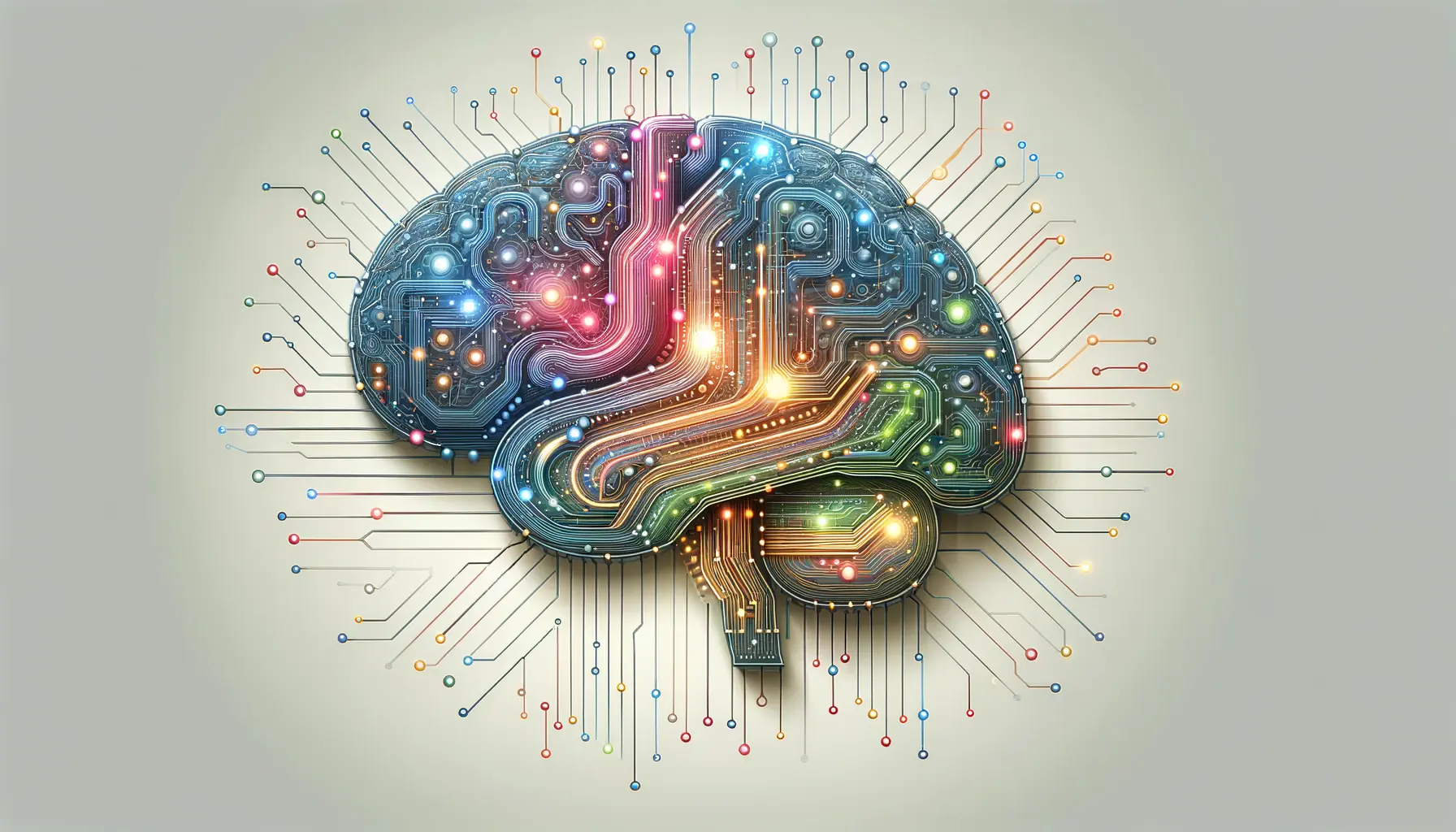Google’s Bard, recently rebranded as Gemini, represents a significant leap forward in the realm of artificial intelligence (AI) and conversational technologies.
This innovative tool, developed by one of the leading tech giants, has sparked interest and curiosity across various sectors, from tech enthusiasts to businesses looking to leverage AI for enhanced customer interaction.
The evolution of Google’s Bard into Gemini marks a pivotal moment in AI development, showcasing Google’s commitment to pushing the boundaries of what AI can achieve in terms of natural language processing, understanding, and generation.
At its core, Google’s Bard, now Gemini, is built on the foundation of Google’s extensive research and development in AI and machine learning.
The technology behind Bard is designed to understand and generate human-like text, facilitating a more natural and intuitive interaction between humans and machines.
This deep dive into the technology behind Google’s Bard will explore the intricacies of its AI model, its capabilities, and how it stands out in the competitive landscape of AI-driven conversational tools.
- LaMDA: The Brain Behind Bard
- The Evolution of Conversational AI
- Applications and Use Cases of Google Bard
- Challenges and Ethical Considerations
- Integrating Bard into Business Strategies
- Future Directions and Technological Advancements
- Maximizing Bard’s Potential in Education and Learning
- Embracing the Future with Google Bard
- Google Bard FAQ: Unveiling AI’s Conversational Marvel
LaMDA: The Brain Behind Bard
Google’s Bard is powered by LaMDA (Language Model for Dialogue Applications), a cutting-edge language model developed by Google.
LaMDA’s design is centered around understanding the context and nuance of human language, enabling Bard to engage in conversations that feel natural and meaningful.
Unlike traditional language models that are limited to responding to specific prompts with pre-defined answers, LaMDA’s flexibility allows Bard to generate responses that are not only relevant but also contextually rich, making each interaction unique.
LaMDA’s architecture is based on the Transformer model, a neural network design that has revolutionized the field of natural language processing.
The Transformer model’s ability to handle sequential data makes it ideal for understanding the flow of human conversation.
This technology enables Bard to comprehend the intricacies of dialogue, from the underlying intent to the emotional tone, allowing for responses that are not just accurate but also empathetically aligned with the user’s needs.
Generative AI and Conversational Fluidity
The generative AI aspect of LaMDA is what sets Bard apart from its predecessors and competitors.
This capability allows Bard to not just answer questions but also to generate content, brainstorm ideas, and even engage in creative tasks.
The model’s training involves vast datasets comprising diverse forms of text, enabling it to learn a wide range of language patterns, styles, and information.
As a result, Bard can assist users in a variety of tasks, from composing emails to generating creative writing pieces, showcasing its versatility as a conversational AI.
Moreover, the generative AI behind Bard is designed to learn continuously from interactions, enhancing its ability to understand and respond to new queries over time.
This aspect of machine learning ensures that Bard remains up-to-date with the latest information and trends, further improving the quality and relevance of its responses.
The integration of Bard into Google’s ecosystem also means that it can leverage the vast amount of information available on the web, providing users with answers that are not only intelligent but also informed by the most current data.
The technology behind Google’s Bard, particularly its LaMDA model, represents a significant advancement in AI’s ability to understand and generate human-like text, setting a new standard for conversational AI tools.
The Evolution of Conversational AI
The journey of conversational AI has been marked by significant milestones, with Google’s Bard, now known as Gemini, being one of the latest and most advanced iterations.
This evolution reflects the growing sophistication of AI technologies and their increasing role in our daily lives.
From simple chatbots to advanced AI-driven assistants, the trajectory of conversational AI showcases a relentless pursuit of creating machines that can understand and interact with humans in a natural and intuitive manner.
Google’s Bard, powered by the LaMDA model, represents a leap forward in this evolution.
It embodies the culmination of years of research and development in natural language processing, machine learning, and AI.
The progression from rule-based systems to machine learning models and now to generative AI highlights the rapid advancements in the field, pushing the boundaries of what conversational AI can achieve.
From Rule-Based Systems to AI Models
- Rule-Based Systems: The early days of conversational AI were dominated by rule-based systems, which operated on predefined rules and responses. These systems were limited in their ability to understand context or handle unanticipated queries, resulting in rigid and often unsatisfactory user experiences.
- Machine Learning Models: The introduction of machine learning models marked a significant shift, enabling conversational AI to learn from data and improve over time. This approach allowed for more flexibility and a better understanding of language nuances, although it still struggled with generating truly natural conversations.
- Generative AI: The advent of generative AI, as exemplified by Google’s LaMDA, has transformed conversational AI. These models can generate responses that are not only contextually relevant but also creatively engaging, offering a level of interaction that closely mimics human conversation.
Impact on User Experience and Accessibility
The evolution of conversational AI has had a profound impact on user experience and accessibility.
Early chatbots often led to frustration due to their limited capabilities and lack of understanding.
However, as conversational AI has advanced, it has become increasingly capable of providing helpful, accurate, and even empathetic interactions.
This progress has not only enhanced user satisfaction but also made technology more accessible to a broader audience, breaking down barriers and democratizing access to information and services.
Moreover, the advancements in conversational AI have opened up new possibilities for its application across various sectors, including customer service, education, healthcare, and entertainment.
The ability of systems like Google’s Bard to understand and generate human-like text has the potential to revolutionize how we interact with technology, making it more intuitive, efficient, and enjoyable.
The evolution of conversational AI, culminating in the development of Google’s Bard, underscores the technology’s potential to redefine human-computer interaction, making it more natural, accessible, and versatile.
Applications and Use Cases of Google Bard
The advent of Google Bard, now Gemini, has opened up a plethora of applications and use cases across various industries.
Its ability to understand and generate human-like text has made it a versatile tool, capable of transforming how businesses and individuals interact with digital technology.
From enhancing customer service to fostering creativity, the applications of Google Bard are as diverse as they are impactful.
As we delve into the specific applications of this groundbreaking technology, it becomes evident that Google Bard is not just a chatbot.
It’s a multifaceted AI companion designed to assist, create, and innovate across different spectrums of personal and professional life.
Enhancing Customer Service
- Automated Support: Google Bard can handle customer inquiries in real-time, providing quick and accurate responses to frequently asked questions. This reduces wait times and improves customer satisfaction.
- Personalized Recommendations: By understanding customer preferences and behavior, Bard can offer personalized product or service recommendations, enhancing the shopping experience.
Boosting Productivity in the Workplace
- Meeting Summarization: Bard can attend virtual meetings, generate summaries, and highlight action items, ensuring that team members stay informed and aligned.
- Document Drafting: From emails to reports, Bard can assist in drafting documents, saving time and streamlining workflow.
Fostering Creativity and Learning
- Creative Writing: Whether it’s crafting stories, composing poetry, or generating creative content for social media, Bard’s generative AI can serve as a muse for creativity.
- Educational Tutor: Bard can provide explanations, solve problems, and offer educational content in a conversational manner, making learning more engaging and accessible.
Revolutionizing Content Creation
The capabilities of Google Bard extend into the realm of content creation, where it can generate articles, blog posts, and even marketing copy.
This not only accelerates the content creation process but also introduces a level of creativity and innovation previously unattainable.
For content creators and marketers, Bard represents a powerful tool for generating ideas, refining messages, and engaging audiences in novel ways.
Moreover, Bard’s ability to analyze and summarize information from the web makes it an invaluable research assistant, helping writers and journalists gather insights and compile data with unprecedented efficiency.
Google Bard’s applications span from improving customer interactions and workplace productivity to enhancing creative processes and content generation, showcasing its potential to revolutionize various aspects of our digital lives.
Challenges and Ethical Considerations
While Google Bard, now Gemini, heralds a new era of conversational AI, its development and deployment are not without challenges and ethical considerations.
As with any advanced AI technology, there are concerns regarding privacy, data security, misinformation, and the potential for bias.
Addressing these issues is crucial to ensure that Bard not only advances technological capabilities but also aligns with ethical standards and societal values.
The integration of Bard into everyday applications offers immense benefits, yet it also raises questions about the responsible use of AI.
Ensuring that Bard operates within a framework that prioritizes user safety and trust is paramount for Google and the broader AI community.
Data Privacy and Security
The ability of Bard to process and generate human-like text is based on vast datasets, including public web content and user interactions.
This raises concerns about data privacy and the security of personal information.
Ensuring that Bard adheres to strict data protection regulations and employs robust security measures to safeguard user data is essential.
Users must be informed about how their data is used and have control over their information to trust and feel comfortable using Bard.
Furthermore, as Bard becomes more integrated into personal and professional tools, the potential for sensitive data exposure increases.
Implementing end-to-end encryption and allowing users to opt-out of data collection for AI training are steps towards mitigating these risks.
Combating Misinformation and Bias
Another significant challenge is ensuring the accuracy of the information generated by Bard and preventing the spread of misinformation.
As Bard relies on the web for information, it may inadvertently generate responses based on inaccurate or biased sources.
Google must continuously update Bard’s training data and algorithms to discern and prioritize reliable information.
Bias in AI is a well-documented issue, stemming from biased training datasets.
Bard must be trained on diverse and inclusive data sets to minimize bias in its responses.
Regular audits and updates to the AI model are necessary to identify and correct any biases, ensuring Bard’s responses are fair and unbiased.
Ethical Use and Societal Impact
The development of Bard also prompts reflection on the ethical use of AI and its impact on society.
Questions about the replacement of human jobs, the erosion of privacy, and the influence of AI on human behavior and decision-making are at the forefront of ethical considerations.
Establishing ethical guidelines for AI development and use, promoting transparency in AI operations, and engaging in open dialogues with stakeholders are vital steps in addressing these concerns.
Moreover, the potential for AI technologies like Bard to be used for malicious purposes, such as creating deepfakes or spreading propaganda, underscores the need for ethical frameworks and regulatory oversight in AI development and deployment.
Navigating the challenges and ethical considerations associated with Google Bard is essential for harnessing its potential while ensuring it serves the greater good and aligns with societal values.
Integrating Bard into Business Strategies
The introduction of Google Bard, now known as Gemini, into the AI landscape presents a unique opportunity for businesses to rethink their strategies and leverage AI to gain a competitive edge.
The application of Bard in business contexts goes beyond mere automation, offering insights into customer behavior, enhancing decision-making processes, and fostering innovation.
As companies seek to adapt to the rapidly evolving digital environment, integrating Bard into their strategic planning can unlock new avenues for growth and efficiency.
Understanding the potential impact of Bard on various business functions is key to harnessing its capabilities effectively.
Here’s how businesses can integrate Bard into their strategies across different domains:
Customer Service and Engagement
- Automated Customer Support: Implement Bard to provide 24/7 customer support, handling inquiries, and resolving issues promptly without human intervention.
- Personalized Customer Experiences: Use Bard to analyze customer data and preferences, delivering tailored recommendations and services that enhance customer satisfaction and loyalty.
Marketing and Content Creation
- Content Generation: Leverage Bard to produce high-quality, engaging content for marketing campaigns, social media, and SEO, saving time and resources.
- Market Analysis: Employ Bard to gather and analyze market trends, consumer feedback, and competitive intelligence, informing strategic marketing decisions.
Product Development and Innovation
- Idea Generation: Utilize Bard’s creative capabilities to brainstorm new product ideas, features, and improvements based on market needs and trends.
- Customer Feedback Analysis: Analyze customer reviews and feedback using Bard to identify areas for product enhancement and innovation.
Operational Efficiency and Decision Making
- Data Analysis and Insights: Integrate Bard to process and analyze large datasets, providing actionable insights that inform strategic decisions and operational improvements.
- Streamlining Processes: Apply Bard to automate routine tasks and processes, freeing up human resources for more strategic activities and reducing operational costs.
For businesses, the key to successfully integrating Bard into their strategies lies in identifying areas where AI can add the most value and implementing it in a way that complements human skills and expertise.
By doing so, companies can not only enhance their operational efficiency but also drive innovation and create more meaningful connections with their customers.
Moreover, as Bard continues to evolve and improve, its potential applications in the business world are likely to expand, offering even more opportunities for companies to leverage AI for strategic advantage.
Staying abreast of these developments and exploring new ways to integrate Bard into business practices will be crucial for companies looking to lead in the digital age.
Integrating Google Bard into business strategies offers a pathway to enhanced customer engagement, operational efficiency, and innovation, positioning companies for success in the digital landscape.
Future Directions and Technological Advancements
The launch of Google Bard, now rebranded as Gemini, signifies not just a milestone in AI development but also sets the stage for future directions and technological advancements in the field.
As we look ahead, the potential for Bard to evolve and integrate with emerging technologies opens up exciting possibilities for enhancing human-AI interaction, pushing the boundaries of creativity, and solving complex problems.
The continuous improvement of Bard’s underlying technology, LaMDA, and its integration into Google’s ecosystem suggest a future where AI becomes even more seamless and intuitive in understanding and responding to human needs.
Here are some anticipated advancements and future directions for Bard and conversational AI:
Enhanced Multimodal Interactions
- Integration with Visual and Auditory Data: Future iterations of Bard could incorporate the ability to understand and generate responses based on images, videos, and audio, making interactions more rich and multidimensional.
- Augmented and Virtual Reality: By integrating Bard with AR and VR technologies, users could experience more immersive and interactive environments, where AI assists in navigating, learning, and creating in virtual spaces.
Personalized AI Companions
- Adaptive Learning: Bard could evolve to become a personalized AI companion that adapts to individual user preferences, learning styles, and behaviors, offering tailored advice, learning resources, and creative inspiration.
- Emotional Intelligence: Future developments might enable Bard to detect and respond to emotional cues, providing support and responses that are not only contextually relevant but also emotionally attuned.
Collaborative AI for Problem Solving
- Cross-Domain Expertise: Bard could collaborate with experts across various fields, synthesizing knowledge to tackle complex, multidisciplinary problems, from climate change to healthcare challenges.
- Real-Time Collaboration: With advancements in real-time processing, Bard could assist teams in brainstorming sessions, offering instant insights, data analysis, and creative input to accelerate innovation.
AI Ethics and Governance
As Bard and similar AI technologies advance, so too will the importance of ethical considerations and governance frameworks.
Developing AI in a manner that respects privacy, ensures fairness, and promotes transparency will be crucial.
Future advancements will likely include more sophisticated mechanisms for addressing bias, ensuring data security, and enabling users to have greater control over their interactions with AI.
The trajectory of Bard and conversational AI is poised to transform not just how we interact with machines but also how we approach creativity, learning, and problem-solving.
By embracing these future directions and technological advancements, we can unlock the full potential of AI to benefit society in diverse and meaningful ways.
The future of Google Bard and conversational AI holds promise for more immersive, personalized, and collaborative interactions, underpinned by a commitment to ethical development and governance.
Maximizing Bard’s Potential in Education and Learning
The integration of Google Bard, now Gemini, into the educational sector heralds a transformative shift in teaching and learning methodologies.
With its advanced natural language processing capabilities, Bard offers a unique opportunity to enhance educational experiences, making learning more interactive, personalized, and accessible.
As educators and institutions explore the potential of this technology, the landscape of education is set to evolve, embracing new ways of engaging students and facilitating knowledge acquisition.
Understanding how to maximize Bard’s potential in educational settings is crucial for harnessing its benefits.
Here are strategies and applications that highlight Bard’s role in revolutionizing education and learning:
Personalized Learning Experiences
- Adaptive Learning Paths: Bard can analyze students’ learning styles, strengths, and areas for improvement, creating personalized learning paths that cater to individual needs, thereby enhancing learning outcomes.
- Interactive Tutoring: By serving as an on-demand tutor, Bard can provide explanations, answer questions, and offer practice exercises in real-time, making learning more responsive and engaging.
Enhancing Curriculum Development
- Curriculum Enrichment: Educators can leverage Bard to incorporate the latest research, case studies, and real-world examples into their curriculum, ensuring that course content remains current and relevant.
- Interdisciplinary Learning: Bard’s vast knowledge base allows for the integration of interdisciplinary perspectives into lessons, encouraging students to make connections across subjects and think critically.
Facilitating Collaborative Learning
- Group Projects: Bard can facilitate collaborative projects by offering ideas, managing tasks, and providing feedback, fostering teamwork and communication among students.
- Global Classrooms: By breaking down language barriers, Bard can connect students from around the world, promoting cultural exchange and global collaboration in learning projects.
Supporting Educators
- Administrative Assistance: Bard can automate administrative tasks such as grading, attendance tracking, and scheduling, allowing educators to focus more on teaching and student engagement.
- Professional Development: Educators can use Bard as a resource for their own learning, staying updated on educational trends, methodologies, and subject matter expertise.
The potential of Bard in education extends beyond the classroom, offering possibilities for lifelong learning, professional training, and self-directed education.
By integrating Bard into educational strategies, institutions can not only enhance the learning experience but also prepare students for a future where AI and technology play a central role in society.
As Bard continues to evolve, its impact on education and learning will likely grow, offering new insights into how AI can support and enrich the educational journey.
Embracing Bard’s capabilities while navigating its challenges will be key for educators and learners alike, as they explore the frontiers of AI-assisted education.
Leveraging Google Bard in education promises to revolutionize learning experiences, offering personalized, interactive, and collaborative approaches to education that prepare students for the future.
Embracing the Future with Google Bard
The journey through the technological marvel that is Google Bard, now known as Gemini, reveals a future where AI transcends its traditional boundaries, offering innovative solutions and enhancing human experiences across various domains.
From revolutionizing customer service to transforming educational landscapes, Bard’s capabilities hint at a new era of interaction between humans and machines.
As we stand on the brink of this new dawn, it’s essential to recognize the potential Bard brings to the table, not just as a tool but as a partner in navigating the complexities of the digital age.
The Path Forward
Integrating Bard into our daily lives and business strategies opens up a world of possibilities.
Its application across industries underscores the versatility and adaptability of AI, promising to drive innovation, efficiency, and growth.
However, as we chart this path forward, it’s crucial to approach Bard’s integration with mindfulness, considering the ethical implications and ensuring that the technology serves to enhance, rather than detract from, the human experience.
- Personalization at Scale: Bard’s ability to tailor experiences and interactions to individual preferences and needs marks a significant advancement in personalization, offering unprecedented levels of engagement and satisfaction.
- Collaborative Innovation: By facilitating collaborative efforts, Bard acts as a catalyst for creativity, bringing together diverse minds and ideas to solve problems and create new opportunities.
- Educational Transformation: In the realm of education, Bard’s potential to personalize learning and make education more accessible and engaging promises to reshape how we learn and teach.
Navigating Challenges with Responsibility
As we embrace Bard’s potential, it’s imperative to navigate the challenges it presents responsibly.
Addressing concerns around data privacy, bias, and misinformation is essential to build trust and ensure Bard’s positive impact on society.
By fostering transparency, prioritizing ethical considerations, and engaging in continuous dialogue with stakeholders, we can harness Bard’s capabilities in a way that respects individual rights and promotes the common good.
Conclusion
In conclusion, Google Bard, with its advanced AI and machine learning technologies, represents a significant leap forward in our quest to harness the power of AI.
As Bard continues to evolve, its impact on various facets of our lives and society at large will undoubtedly grow, offering new ways to interact, create, and solve problems.
By embracing Bard’s potential while conscientiously addressing its challenges, we can look forward to a future where AI and humans collaborate seamlessly to create a world that is more connected, creative, and informed.
The journey with Bard is just beginning, and the possibilities are as limitless as our imagination.
Google Bard FAQ: Unveiling AI’s Conversational Marvel
Explore the most frequently asked questions about Google Bard, now known as Gemini, and discover insights into its capabilities, applications, and future potential.
Google Bard, now Gemini, assists with writing, planning, learning, and more by leveraging Google AI to access a breadth of knowledge.
Initially limited, Google Bard is now accessible in the U.S. and U.K. for users to collaborate with generative AI.
Bard boosts productivity by summarizing articles, brainstorming content, and retrieving information from Google apps.
Yes, Bard is designed to brainstorm and generate various types of creative content, enhancing creativity and content creation.
Bard’s limitations include handling complex queries that may require understanding nuanced or subjective information.
Bard adheres to strict data protection regulations, employing robust security measures to safeguard user data.
Yes, Bard serves as an educational tool, offering personalized learning experiences and interactive tutoring.
Future advancements for Bard include enhanced multimodal interactions, personalized AI companions, and collaborative problem-solving capabilities.













